#southern elephant seal
Text
Today's Seal Is: Screaming Contest
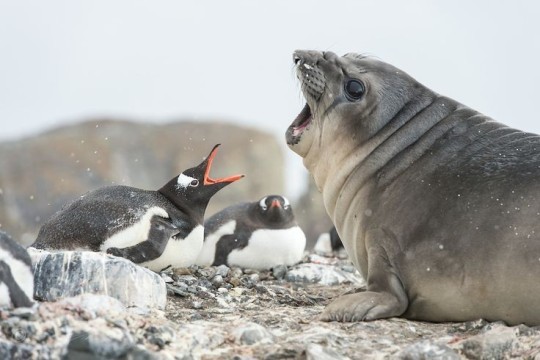
7K notes
·
View notes
Text




As pups, Elephant seals are very curious of their surroundings and often go up to investigate photographers (who aren’t allowed to touch them and instead have to sit there getting poked and crawled on by these very large babies)
4K notes
·
View notes
Note
Begging you for some pinnipeds any pinnipeds please
Piebald Northern fur seal
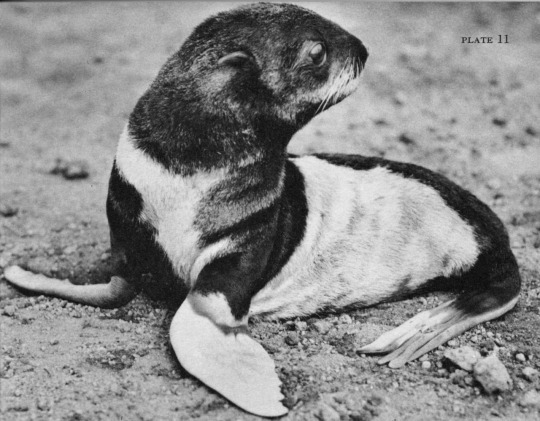
Atypical colored Antarctic fur seal! With the orange, white, and grey they look calico.
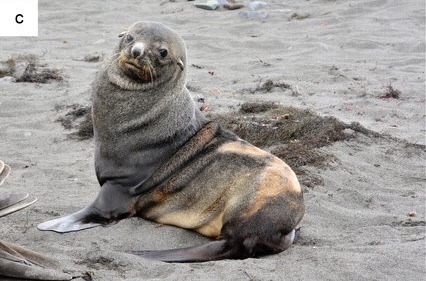
Leucistic Antarctic fur seal

Interesting gang of Antarctic fur seal, one is leucistic and one almost looks brindle?

Leucistic southern elephant seal

Northern fur seal labeled as albino and partial albino (leucistic?) by some sources. NOAA says albino and they are experts.

Albino harbor seal
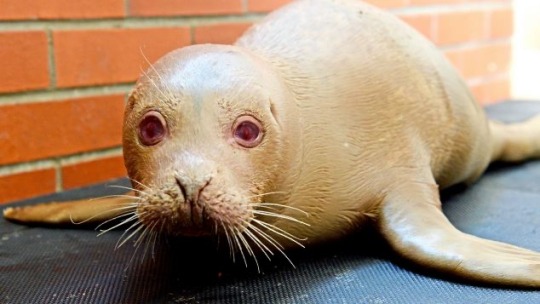
Albino ringed seal
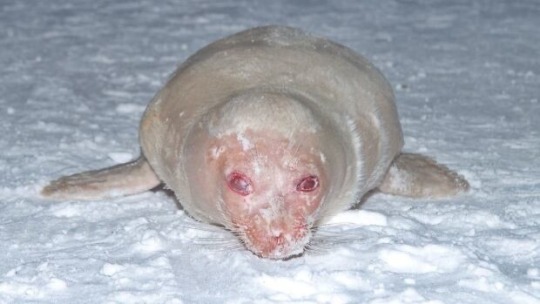
Melanistic grey seal
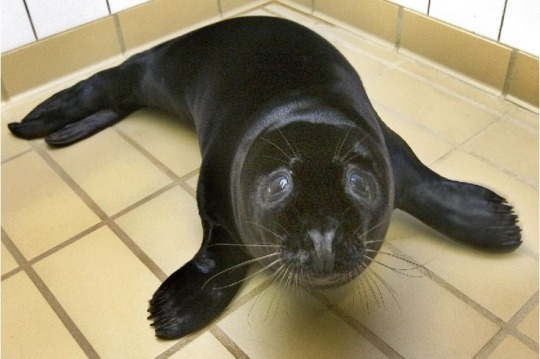
#color mutation#albino#albanisim#melanistic#melanism#piebald#leucism#leucistic#oddball#northern fur seal#Callorhinus ursinus#antarctic fur seal#Arctocephalus gazella#harbor seal#Phoca vitulina#ringed seal#Pusa hispida#southern elephant seal#Mirounga leonina#grey seal#Halichoerus grypus#ask
626 notes
·
View notes
Photo
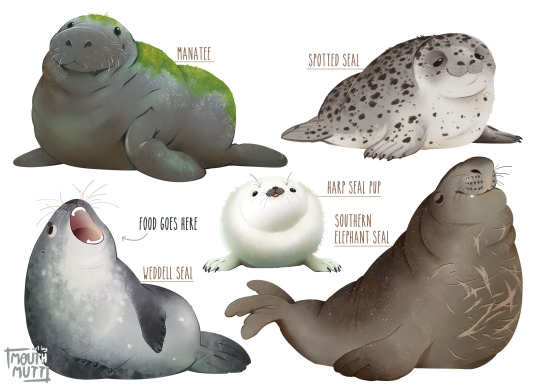
Seals
Some fun painting practice from a while back!
Twitter / Bluesky / Instagram / Furaffinity / Website
#digital art#animal art#seals#manatee#weddell seal#harp seal#southern elephant seal#spotted seal#seal#myart#Mouthmutt#silkwurm#silkwurmart
490 notes
·
View notes
Text

#0044 Neil the Seal
A little charmed by Tasmania's Chaotic Neutral Southern elephant seal (Mirounga leonina), Neil.
#neil the seal#tasmania#australia#southern elephant seal#daily art#ink and wash#watercolors#brush pen#fauna#ocean life
25 notes
·
View notes
Photo
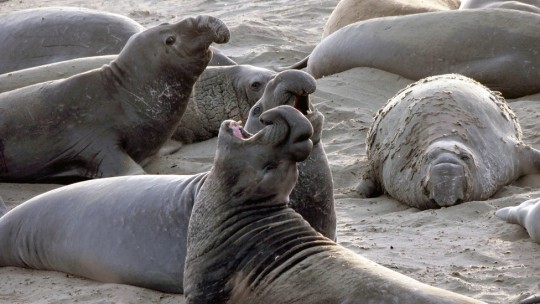

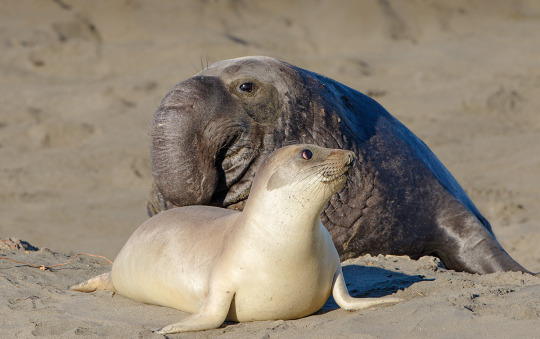
Elevating the Elephant Seal
Found all along the Pacific coast, from Alaska to Antarctica, elephant seals are famous for their size, aggression, and unusual noses. There are two species of elephant seal, both belonging to the true seal family Phocidae. The northern elephant seal (Mirounga angustirostris), as its name suggests, is dispersed along the northern coasts of North America, from the American state of Alaska all the way down to Baja California in Mexico. Southern elephant seals (Mirounga leonina) reside in Antarctic and sub-Antarctic waters up to the southern most regions of Chile and Argentina in South America. Both species migrate twice a year. The rest of the year is spent foraging in the deep waters of the Arctic or Antarctic, respectively, and these trips can take anywhere from 10,000km to 20,000, making them one of the longest migrations of any marine mammal.
The main difference between northern and southern elephant seals is their size. A male northern elephant can weigh between 1,500 and 2,300kg, while females are much smaller at 400 to 900 kg. M. angustirostris also has a shorter nose than its southern cousin. M. leonina females are similar in size to the northern elephant seals, at 400 to 900 kg, but males can easily reach up to 4,000kg, making them the largest species of seal on the planet. Both elephant seal species are generally brown in color and have only a short, bristly coat of hair. They have no ears, distinguishing them from other pinnipids like sea lions. The males, or bulls, of both species also have pronounced nose called a proboscis which serves to amplify loud mating or threatening calls.
Elephant seals come ashore twice a year in groups called colonies. In the summer, individuals gather on land to go through a ‘catestrophic molt’. During this time, the fur and the top layer of skin peel from the body. This is a necessary process because when at sea, blood is not circulated to the skin in order to keep elephant seals warm. Because of this, they are also unable to grow new hair or skin continuously. When the outer layers of skin and hair wear down or become ragged, individuals travel to traditional breeding grounds and take a month to shed their outer layers and grow a new protective coat.
From December to March, dominant males congregate at breeding grounds to compete for mating rights. The bulls are very aggressive, and fight by slamming their bodies together and raking each other with their sharp canines. Once a bull has established dominance on a beach, other males typically leave, though some may try to sneak back in to mate when the alpha bull isn’t looking. Each dominant male controls a harem of 40 to 50 females. Each female, or cow, only gives birth to one or two pups after a gestation period of 10 to 12 months. Only a few days after giving birth, she is ready to mate again.
In the meantime, the mother nurses her pup almost constantly for about a month. During this time, the female does not leave the beach to search for food, and both she and the bulls lose up to a third of their body weight. After about a month the mother weans her pup off her milk. However, some pups are “super weaners” and will search out another female-- usually one who has lost her pup-- and nurse from her for as long as possible. This gives the pup a significant size advantage: pups that are successfully weaned at 6 weeks weigh only 160kg, while super weaners can weigh up to 270 kg. The advantage of being this big is in the blubber: elephant seals require large amounts of excess fat as an energy source when food is scarce and to keep them warm when they forage in the cold waters of the northern or southern Pacific Ocean. However, the effectiveness of this strategy for survival has yet to be fully determined. The average lifespan of M. angustirostris is 9 years, while M. leonina can live up to 21 years old, though in both species males tend to die much sooner than females.
Outside the molting and mating seasons, elephant seals spend up to 90% of their lives in the water, usually alone. Foraging migrations require long, deep dives into the cold Arctic or Antarctic oceans to search for squid, rays, small sharks, and schooling fish. Some of these dives are the deepest recorded for any non-cetacean mammal at up to 1,550m below the surface. To reach these depths, elephant seals can hold their breath for almost two hours, although the average length of a dive is 20-60 minutes. Due to their large size, adult elephant seals have few predators. Some sharks, like great white sharks (Carcharodon carcharias) and southern sleeper sharks (Somniosus antarcticus) will go after adults when desperate. More common is predation on elephant seal pups; killer whales (Orcinus orca), leopard seals (Hydrurga leptonyx), and New Zealand sea lions (Phocarctos hookeri) will all hunt young pups when no parents are nearby to defend them.
Conservation status: The IUCN has rated both elephant seal species as Least Concern. In the late 1800s, northern elephant seals were thought to be hunted to extinction but a population of 20-100 individuals was discovered on Guadalupe Island off Baja California. Southern elephant seals were also hunted, but to a lesser extent. M. angustirostris and M. leonina populations are now well in the hundreds of thousands, though the population of southern elephant seals is declining once more due to disruption of their primary food sources.
Photos
Taiki Adachi
Nick Ut
Steve Zamek
If you like what I do, consider buying me a ko-fi!
#northern elephant seal#southern elephant seal#carnivora#phocidae#elephant seals#seals#pinnipeds#carnivores#mammals#coasts#coastal mammals#open ocean#open ocean mammals#pelagic fauna#pelagic mammals#north america#western north america#south america#western south america#antarctica#pacific ocean
79 notes
·
View notes
Video
92 notes
·
View notes
Text
Project partner: "Sadly I can't find anything other than angler fish that uses bioluminescence to attract prey... I guess I'll just do that..."
Me, a professional finder of information thanks to the small fandoms I'm in: "Say no more!"
#did you know that olindias are jellyfish that attract prey with their bioluminescent tentacles?#did you also know that certain bioluminescent bacteria let themselves be eaten to gain access to an organism's nutrients?#did you /also/ know that southern elephant seals are sensitive bioluminescent light and use that to locate bioluminescent prey?#did you know-
3 notes
·
View notes
Text
honourable mentions who couldnt fit :(
crabeater seal
spotted seal
all the fur seals
201 notes
·
View notes
Text
I haven't covered any pinniped pals for Wet Beast Wednesday yet, so for my first one I'm going big. Really big. Elephant seal big. Elephant seals are not only the largest of all pinnipeds, they are the largest of all carnivorans and the largest marine mammals that aren't cetaceans. There are two species: northern (Mirounga angustirostris) and southern (Mirounga leonina), with the southern species being the larger of the two.
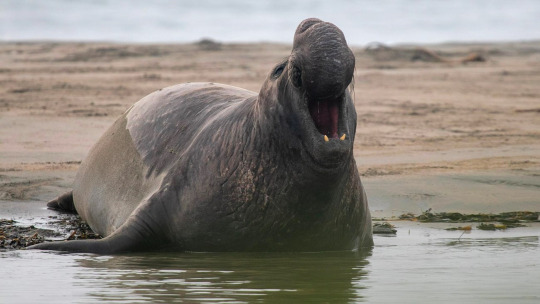
AAAAAAAAAAAAAHHHHHHHHH! (image: an elephant seal bellowing)
Elephant seals are true seals (as opposed to sea lions and walruses), meaning they lack external ears and their hind legs have fused into a sort of pseudo-flipper that allows for highly efficient swimming but is of little use when maneuvering on land. While it is common among pinnipeds for males to be larger than females, elephant seals exaggerated that with one of the most extreme size differences between sexes. Females of both species range from around 350 to 900 kg (880 to 1,980 lbs) and 2.5 to 3.6 m (8.2 to 11.8 ft) in length. Male northern seals average between 1,500 to 2,300 kg (3,300 to 5,100 lbs) and 4-5 m (13-16 ft) while southern males break the scale at 1,500 to 3,700 kg (3,300 to 8,200 lbs) and 4.2 to 5.8 m (14 - 19 ft). The southern species has the largest mass difference between sexes of any mammal, with the males averaging 5-6 times the weight of the females.

(image: male and female elephant seals chillaxing on a beach)
In addition to the size difference, the other major form of sexual dimorphism is that the male has his nose elongated into a proboscis. This snout serves two major functions: it amplifies the roars of the male allowing him to be remarkably loud and it traps and reabsorbs moisture when he exhales. This is important as the seals do not eat or drink when on land and recapturing moisture lets him stay hydrated.
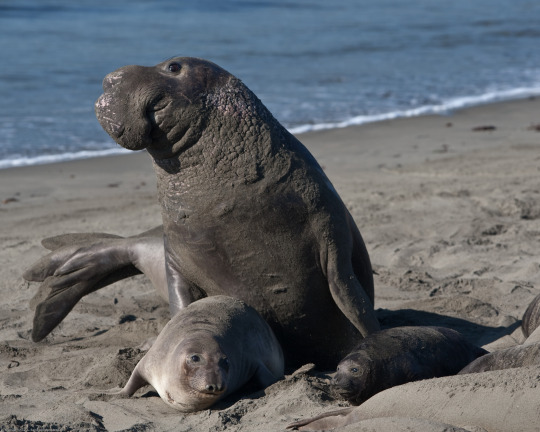
(image: a male[top], female [bottom left] and juvenile [bottom right] northern elephant seal)
Seals are adapted to spend the vast majority of their lives in the water and elephant seals are no different. They spend around 80% of their lives in the water and have many adaptations to aid in their lifestyle. Like most marine mammals, they have a thick layer of fatty blubber that preserves heat in cold water, reduces drag, and provides buoyancy. Like other seals, they can slow their heartbeats and redirect blood flow to the core of their body to avoid losing heat. Another seal adaptation is that veins returning blood to the heart grow near arteries carrying blood from the heart. This allows the cold returning blood to leech some heat from the arteries to avoid cooling down the body's core. They have a lot of blood to store oxygen, allowing for long dives. Elephant seals dive deep (averaging 300-600 m but occasionally much deeper) when searching for food. Females typically go on deeper but shorter dives than males. They can hold their breath for over 100 minutes, longer than nay non-cetacean mammal.. Their eyes are highly adapted to low-light conditions and their whiskers can sense motion in the water, both things that aid in finding food. Elephant seals are very opportunistic predators and will eat a large variety of fish and cephalopods.

(image: a female elephant seal swimming)
The 20% of time not spent at sea is mostly taken up by two yearly periods: the molting and breeding seasons. In both cases, the seal will haul out onto the beach and will not eat or drink until it has finished. Molting season lasts about a month and usually occurs in summer. Elephant seals undergo what are called catastrophic molts, where they not only shed and regrow their fur but their outer layer of skin. During the regrowth of their skin, extra blood has to be directed toward it. In the water, this would cause too much heat loss, so it must be done on land. The skin sheds in large patches and not all at once, resulting in molting seals having a ragged appearance.
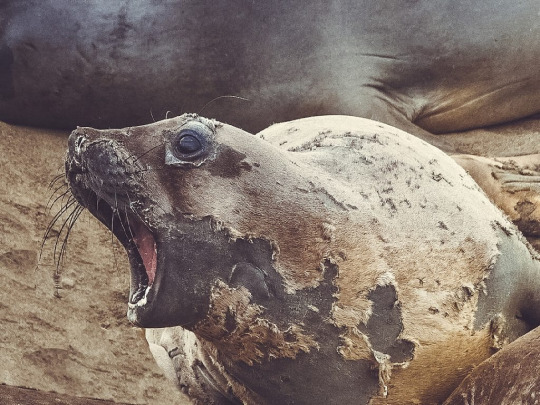
(image: a seal mid-molt)
The longer and more famous time on land is breeding season. In early spring, males will arrive on beaches and fight each other for dominance. In time, a few alpha males will claim most of the beach. These fights last even after the females arrive. Fights are very dramatic, involving posing and bellowing. If one male does not submit, they will fight by biting and slapping each other with their heads. Fights are rarely fatal, but are frequently bloody. Males have thicker skin on their chests to protect them during fights. Alpha males claim the right to mate with the females. Other males are forced to the outskirts of the beach, where they try to mate while the alpha is distracted. Some males will become betas, who help the alpha patrol his territory and drive off competing males. These betas will often try to mate while the alpha is distracted. Only the largest and strongest males can claim alpha status, and usually late in life when they have grown to their largest. After the females arrive, mothers will give birth to their pups. After birth, the female uses unique vocalizations so her pup can always recognize her. They nurse pups for up to 28 days while the males continue to fight. Elephant seal milk is extremely high in fat content, with up to 50% of the milk being fat, compared to 3.5% for cows. Some mothers may adopt the pups of others, especially if their own pup died before weaning. Weaning is very abrupt, after which the females will mate and the adults will return to the sea. The pups are left on land for up to 10 weeks, where they must learn how to swim and hunt while subsisting off the energy stores they built up while nursing. Juvenile mortality is high, with up to 50% of pups dying before reaching maturity. Adults can lose a third of their weight during breeding season.
youtube
(video: a clip from the BBC documentary Seven World One Planet about males fighting fro dominance. warning: there is blood)
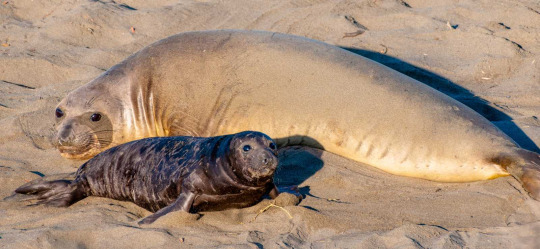
(image: a mother seal and pup)
A few pups are known as super weaners because they can grow exceptionally large during nursing. This is usually due to the pup being adopted by an additional female and therefore getting an extra dose of milk or it will steal milk from another pup. In a few cases, the mothers will just wait longer before weaning for unknown reasons. Average pups weigh between 110 and 160 kg (250 - 350 lbs) at weaning while super weaners can weigh up to 270 kg (600 lbs). They can put on so much blubber their ability to move becomes impaired. Super weaners are rarely observed again after leaving the rookery. It has been speculated that their excess blubber makes them exceptionally buoyant, reducing their ability to dive and making it harder to feed, leading to increased mortality.

(image: a chonky baby super weaner)
Both species of elephant seal were hunted to near-extinction in the 19th century as their blubber could be used to make exceptionally high-quality oil. After the hunting period ended, their numbers increased to the point both species are classified as least concern by the IUCN, though their populations have never risen to pre-hunting numbers and many areas that were historically occupied are now vacant. Genetic bottlenecks in both species has led to an increase in diseases and birth defects. El Nino is known to have a negative effect on northern seals by drastically increasing pup mortality, so this year was probably a bad one. One major limiting factor in their population growth is a lack of beaches to haul out on and many beaches they use are now protected by local laws or as UNESCO World Heritage Sites.

(Gif: a female versus a car. Round 1, fight!)
#wet beast wednesday#marine biology#biology#zoology#ecology#elephant seal#marine mammals#seal#seals#absolute unit#animal facts#cw animals fighting#chonky#Youtube
276 notes
·
View notes
Text

Southern elephant seal
By: W. Chas. Swett
From: Natural History Magazine
1936
56 notes
·
View notes
Text
Today's Seal Is: The Bucket Elder

#Ever since i posted bucket boy i realised i forgot...**Him**#seals#pinniped#daily#mod ribbon#phocidae#elephant seal#southern elephant seal
2K notes
·
View notes
Note
idk if this counts as a 'questionable do you have any facts for any seals? :o
Oh so sorry it took so long. I got some stuff to do and now it's time for some seal's facts:
Seals typically sleep on land when they have pups or are searching for warmth. When sleeping in the water, seals are usually in a position called “bottling” where their bodies (except for their snout) remain completely underwater.
Seals and sea lions belong to a group of marine mammals called “pinnipeds.” In Latin, “pinniped” means “fin-” or “flipper-footed.” There are currently 33 different species of seals. The largest seal species is the Southern elephant seal, and the smallest is the ringed seal
Earless seals, including the walrus and leopard seal, don’t look like they have ears at first glance. However, they’re actually hiding underneath the surface of their skin. What’s missing is a pinna (a visible external ear
While not related to dogs, seals share certain traits. They’re known to be curious, playful, and sociable. But remember, seals are protected by the Marine Mammal Protection Act which makes it illegal to harass, pursue, or take animals from their environment.

62 notes
·
View notes
Text

Puerto Madryn Cruise Port, Argentina: Located on the northern coast of Argentina’s Patagonia region, Puerto Madryn is the gateway to Valdes Peninsula, a popular marine wildlife viewing destination. The peninsula is home to a large population of the endangered southern right whales, dolphins, elephant seals, penguins, and more. Puerto Madryn is also a jumping-off point for exploring Punta Tombo, Argentina’s largest colony of Magellanic penguins. Travelers arriving at the Puerto Madryn cruise port often head out on a full-day excursion to the Punta Tombo Penguin Preserve
47 notes
·
View notes
Photo
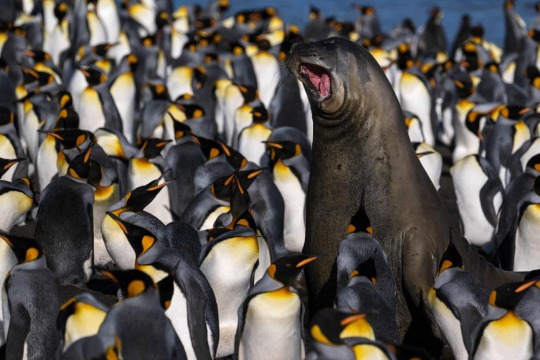
An elephant seal is surrounded by penguins (Manchots Royaux), on Desolation Island, part of the Crozet Islands, a sub-Antarctic archipelago of small islands in the southern Indian Ocean. The Crozet Islands are home to four species of penguins. Most abundant are the macaroni penguin, of which some 2 million pairs breed on the islands, and the king penguin, home to 700,000 breeding pairs; half the world’s population. Mammals living on the Crozet Islands include fur seals and southern elephant seals. Killer whales have been observed preying upon the seals
Photograph: Patrick Hertzog/AFP/Getty Images
#patrick hertzog#photographer#afp via getty images#elephant seal#seal#animal#mammal#wildlife#penguins#manchots royaux#desolation island#crozet islands#indian ocean
87 notes
·
View notes
Note
i feel like Taliesin would dislike seals given they’re the combo of the things he hates the most— just dogs that are in water that will bark at him while also being capable of dragging him under the surface if they so please
Fun fact: Seals do exist in the Elder Scrolls setting! Next to Horkers being close runner ups.
And while they're given nicknames such as sea dogs or sea puppies, Taliesin has no problem with them. They're not dogs to him. And he knows not to approach one because he's aware of the bacteria that seals carry on their teeth and skin. He'll enjoy a seal at a distance.
29 notes
·
View notes